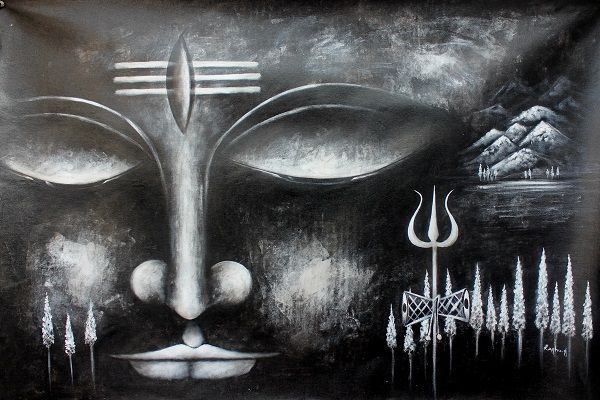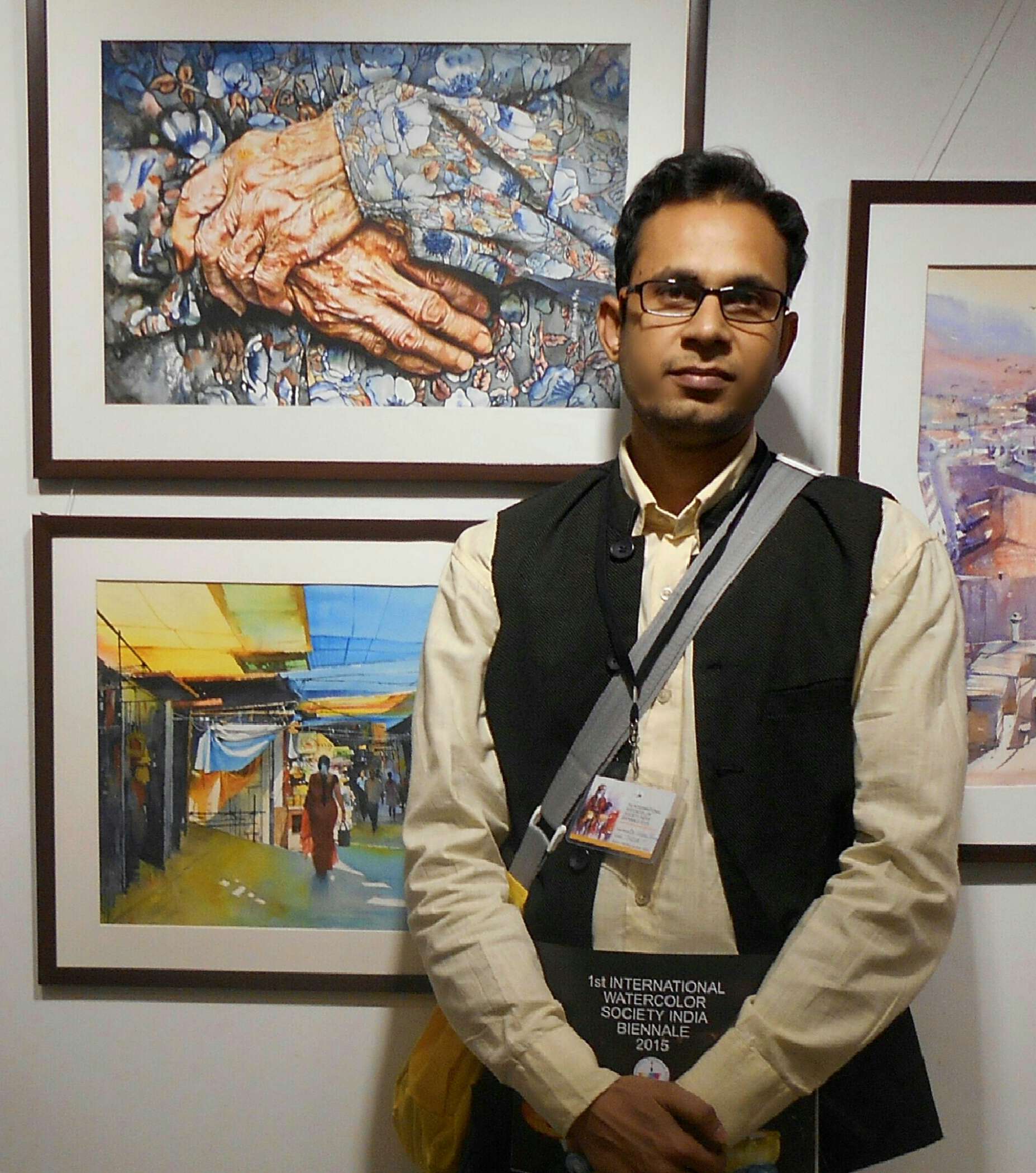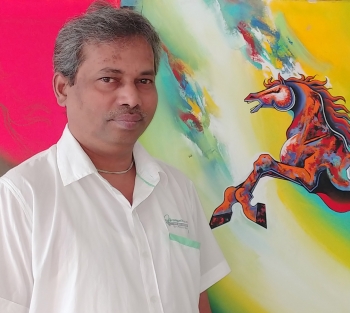
Before the creation itself, there ensued a heated argument between the two gods i.e. the Brahma and the Vishnu. This mythological anecdote is depicted religiously in Lord Shiva paintings. Their respective egos wanted to prove that one of them was more powerful than the other. While they were debating, a blazing pillar emerged out of thin air.
This pillar of infinite length or Sada-Shiva seemed to have no beginning and end. Brahma and Vishnu agreed to find the end and the beginning respectively and decided that whoever located their respective destinations would be victorious.
Lord Brahma set out in the form of a goose and Vishnu took a form of a boar and started digging to reach the roots. He came back humbled and admitted that he was unable to find the extent of the mighty pillar while Lord Brahma fabricated a lie that he has located the provenance of the pillar and Ketaki flower also supported his false claim.
After this, Lord Shiva manifested in front of them through that pillar and laid a curse upon Ketaki and Lord Brahma. Thus, he is the destroyer of ego and lord of spiritual awakening.
I looked at Lord Shiva paintings having a bewildered look on my face and a storm of questions in my mind. The most pertinent and pressing among those was that why Lord Shiva has three eyes. I thought since he was god and had more complex things to do than us, so he might need a third eye to see a little extra.
Also Read: Significance of Lord Shiva Paintings
But, the truth was beyond my wildest imagination. Let us clear the mist on the most sought after mystery.
Shiva is one of the holy trinity of Brahma and Vishnu. Brahma created this universe while Vishnu is responsible for maintaining it. Shiva is the supreme force that can destroy as Rudra and reform as Shankar. Every attribute through which we identify him have different meanings. Some of them are explained as follows:-
- Body besmeared in ashes- This shows that he is above the cycle of birth and death. This also signifies that death is the ultimate truth and one can’t escape it.
- Adorning the tiger skin- I got confused a bit after seeing that. How could the principal deity of Hindus wear a tiger skin despite Hindus having aversion to killing of living beings? The true meaning behind is: tiger is considered as consciousness which is full of worldly desires. Lord Shiva has overcome his desires and is unaffected by his senses. He sees what lies beyond the materialism.
- An endless coil of cobras around their necks- Lord Shiva wears a deadly cobra around his neck to show that he is not bound by the constraints of life, death and time. He is Swayambhu or self-created.
- Half hooded eyes- His countenance is so calm and blissful. It seems as if he has acquired a state where no sorrow or happiness could touch him. He is the Adiyogi.
All these symbols of Shiva have a different story to tell. But, what people do is that they take these mythologies literally. Mythologies are to be interpreted as law. They have a broader meaning serving a much larger purpose. Owing to general ignorance and misinterpretation, Hindu mythology is often misconceived despite its accommodating and universal nature.
Shiva’s Third Eye: A Higher State of Consciousness
Shiva’s third eye is often seen as closed in many Indian paintings. According to a popular belief, it should remain like that if this creation wants to sustain. Shiva can destroy the whole existence and turn it into a pile of ashes if he opens his third eye as it destroys everything on which his gaze falls. Let us try to understand the origin of this.
The most popular tale describing the wrath of Lord Shiva is the one that relates to the god of desire or Kamadeva. According to a story in Shiva Purana, Lord Shiva reduced the Lord of love to nothing with his gaze full of rage.
Also Read: The true interpretation of Shiva's Third Eye
When Sati, Shiva’s first wife, jumped into fire meant for worshipping gods and left Shiva, he became a recluse and starting meditating in a cave doing rigorous meditation. Entreaties of every god and goddess failed but, he did not budge from his place. Parvati- an incarnation of Sati was also trying hard so that she could marry Shiva and make him a part of domesticated life once more.
Kaamdev was given the task of awakening desires in Lord Shiva while he was meditating. He shot a flowery arrow with his sugarcane bow towards Lord Shiva to make him desirous of Parvati. Shiva opened his third eye and destroyed him at once by the intense stream of fire which came out of his third eye.
Without the god of desire, the entire existence got misbalanced. There was actually nothing left that could be balanced. When there is no desire, there is no right or wrong, no give and take. So, literally, he killed the god of desire in anger. But, the true meaning of this story lies in symbolical interpretation. Otherwise, it is a mere story like any other. It is the hidden wisdom that makes it special.
The human mind is divided into two parts, according to Daniel Kahneman in his most coveted book ‘Thinking Fast and Slow’. One brain is responsible for the survival instinct or the animal impulse which is natural. The evolutionary process made it like that. All animals have this type of brain. They do not identify social norms as we do. This brain is known as System 1.
There is another System 2 which is made up of our consciousness through which we outrun our basic impulses and make intelligent decisions. Scientists have succeeded in locating this higher brain through MRIs. It is located right behind our forehead where the iconic Shiva’s third eye is present.
Also Read: Contemplating the Irrefutable Thirst to Buy Shiva Paintings
If we pursue the instincts of the lower brain, we are nothing but animals. The human brain promises much more. It makes deliberate decisions based on practicalities. Nature and survival instinct don’t control this behaviour of ours. Therefore, we can say that we open our third eye, a higher level of consciousness when we make decisions from our higher brain.
This means that the third eye is nothing but the awakening of our wisdom so that we can make decisions after weighing the pros and cons unaffected by instincts.





















